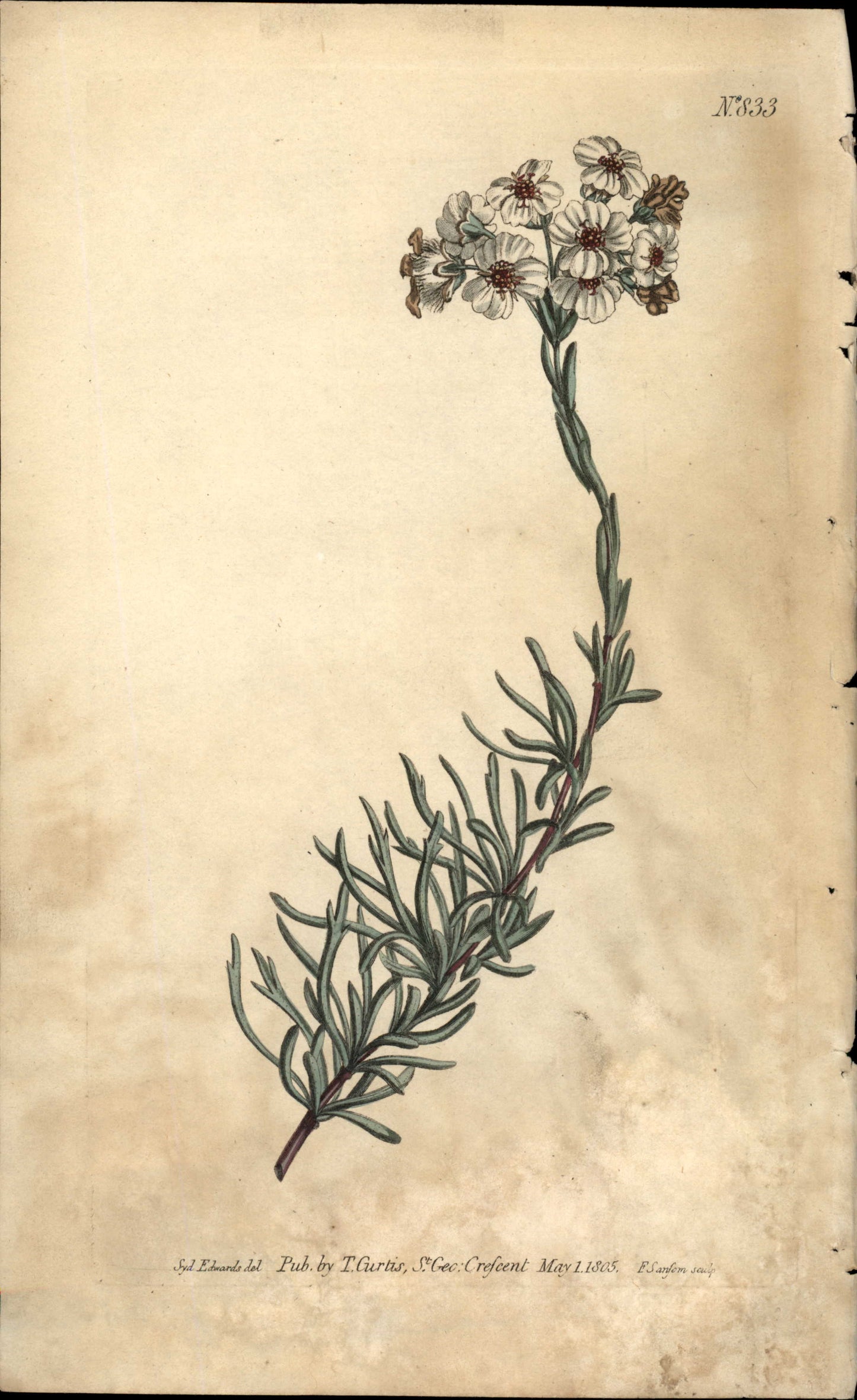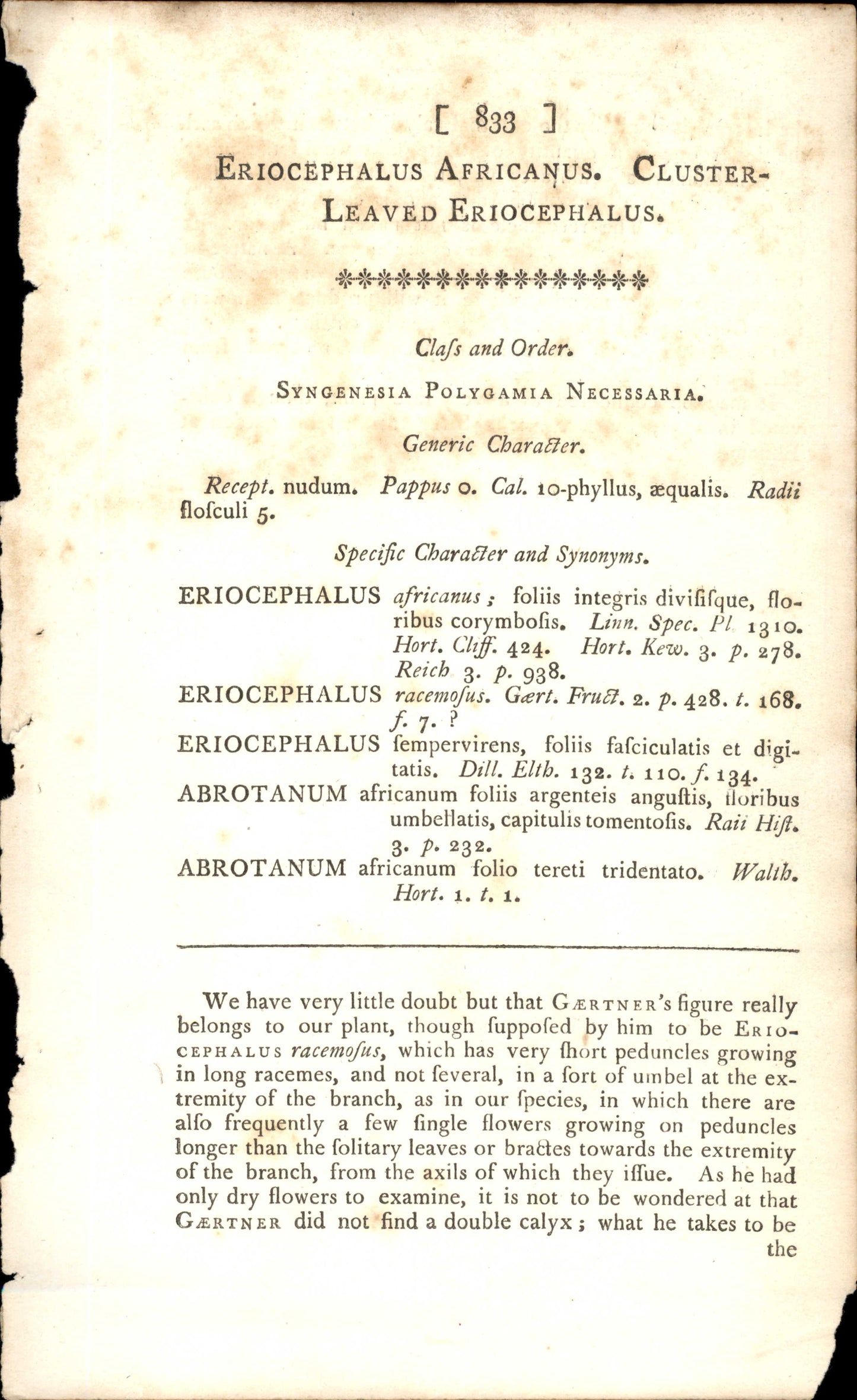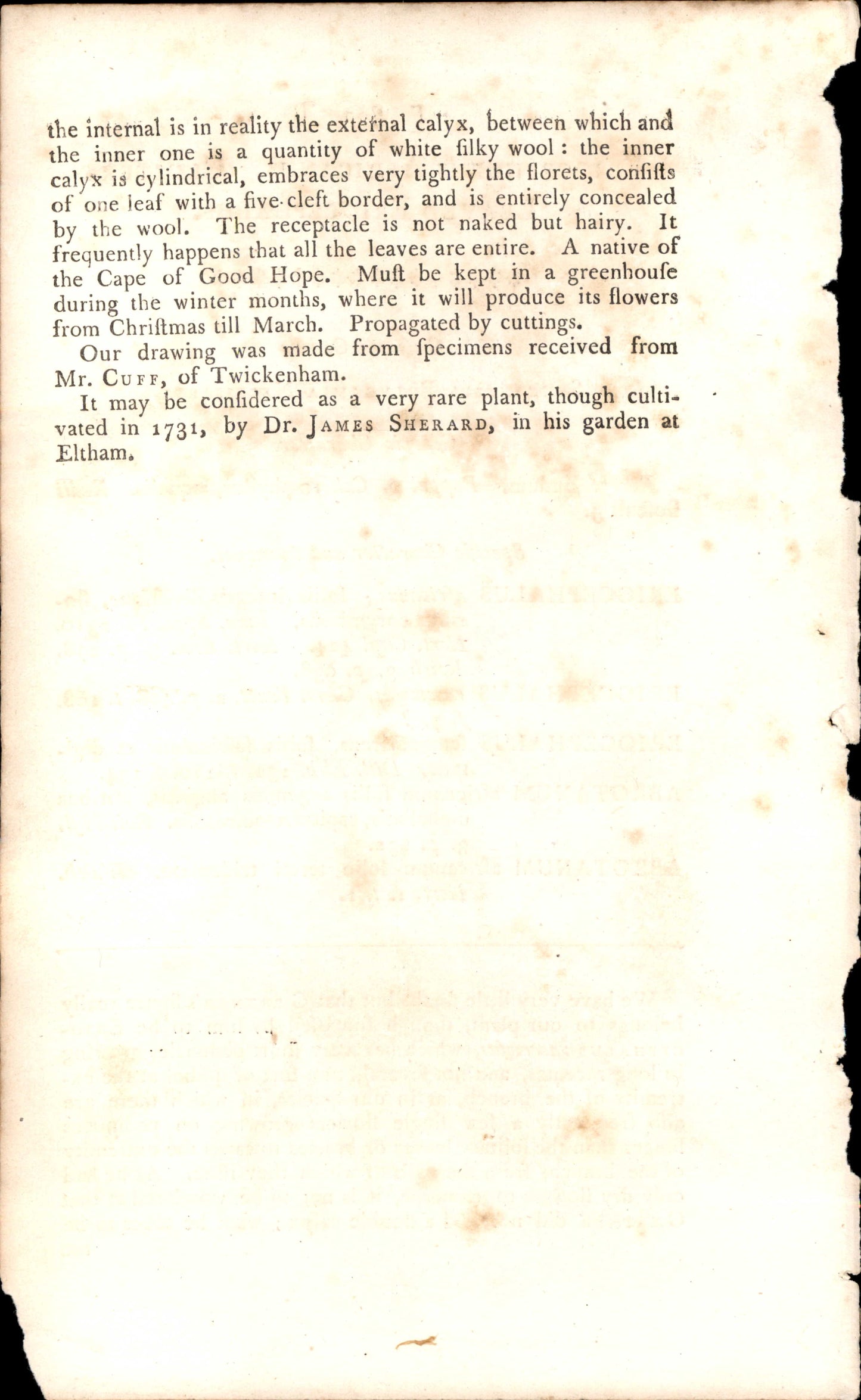Curtis Botanical Magazine
Plate 833 - Cluster- Leaved Eriocephalus
Plate 833 - Cluster- Leaved Eriocephalus
Couldn't load pickup availability
Plate 833
Classification: SYNGENESIA POLYGAMIA NECESSARIA
Flowering Period: May
Publication Date: Pl 1310
Description:
Complete Botanical Text (Cleaned)
N833 syd Edwards del Pub. by T.Curtis, sGec: Crefcent May 1.1805.
ESanfem seulp [833] ERIOCEPHALUS AFRICANUS.
CLUsTER- LEAVED ERIOCEPHALUS. ************ Class and Order. sYNGENESIA POLYGAMIA NECEsSARIA.
Generic Character.
Recept. nudum.
Pappus o.
Cal. 10-phyllus, æqualis.
Radii flofculi 5. specific Character and synonyms.
ERIOCEPHALUS africanus; foliis integris divififque, flo- ribus corymbofis.
Linn. spec.
Pl. 1310.
Hort.
Cliff. 424.
Reich 3. p. 938.
Hort.
Kew. 3. p. 278.
ERIOCEPHALUS racemofus.
Gært.
Fruct. 2. p. 428. t. 168. f. 7. ? ERIOCEPHALUS sempervirens, foliis fasciculatis et digi- tatis.
Dill.
Elth. 132. t. 110. f. 134.
ABROTANUM africanum foliis argenteis anguftis, floribus umbellatis, capitulis tomentofis.
Raii Hift. 3.
P. 232.
ABROTANUM africanum folio tereti tridentato.
Walth.
Hort. 1. t. 1.
We have very little doubt but that GERTNER's figure really belongs to our plant, though supposed by him to be ERIO- CEPHALUS racemofus, which has very short peduncles growing in long racemes, and not feveral, in a fort of umbel at the ex- tremity of the branch, as in our species, in which there are also frequently a few fingle flowers growing on peduncles longer than the solitary leaves or bracttes towards the extremity of the branch, from the axils of which they iffue.
As he had only dry flowers to examine, it is not to be wondered at that GERTNER did not find a double calyx; what he takes to be the the internal is in reality the external calyx, between which and the inner one is a quantity of white filky wool: the inner calyx is cylindrical, embracts very tightly the florets, confifts of one leaf with a five cleft border, and is entirely concealed by the wool.
The receptacle is not naked but hairy.
It frequently happens that all the leaves are entire.
A native of the Cape of Good Hope.
Must be kept in a greenhoufe during the winter months, where it will produce its flowers from Chriftmas till March.
Propagated by cuttings.
Our drawing was made from specimens received from Mr.
CUFF, of Twickenham.
It may be confidered as a very rare plant, though culti- vated in 1731, by Dr.
JAMES sHERARD, in his garden at Eltham
Raw OCR Text (Original)
N833 syd Edwards del Pub. by T.Curtis, sGec: Crefcent May 1.1805. ESanfem seulp [833] ERIOCEPHALUS AFRICANUS. CLUsTER- LEAVED ERIOCEPHALUS. ************ Class and Order. sYNGENESIA POLYGAMIA NECEsSARIA. Generic Character. Recept. nudum. Pappus o. Cal. 10-phyllus, æqualis. Radii flofculi 5. specific Character and synonyms. ERIOCEPHALUS africanus; foliis integris divififque, flo- ribus corymbofis. Linn. spec. Pl. 1310. Hort. Cliff. 424. Reich 3. p. 938. Hort. Kew. 3. p. 278. ERIOCEPHALUS racemofus. Gært. Fruct. 2. p. 428. t. 168. f. 7. ? ERIOCEPHALUS sempervirens, foliis fasciculatis et digi- tatis. Dill. Elth. 132. t. 110. f. 134. ABROTANUM africanum foliis argenteis anguftis, floribus umbellatis, capitulis tomentofis. Raii Hift. 3. P. 232. ABROTANUM africanum folio tereti tridentato. Walth. Hort. 1. t. 1. We have very little doubt but that GERTNER's figure really belongs to our plant, though supposed by him to be ERIO- CEPHALUS racemofus, which has very short peduncles growing in long racemes, and not feveral, in a fort of umbel at the ex- tremity of the branch, as in our species, in which there are also frequently a few fingle flowers growing on peduncles longer than the solitary leaves or bracttes towards the extremity of the branch, from the axils of which they iffue. As he had only dry flowers to examine, it is not to be wondered at that GERTNER did not find a double calyx; what he takes to be the the internal is in reality the external calyx, between which and the inner one is a quantity of white filky wool: the inner calyx is cylindrical, embracts very tightly the florets, confifts of one leaf with a five cleft border, and is entirely concealed by the wool. The receptacle is not naked but hairy. It frequently happens that all the leaves are entire. A native of the Cape of Good Hope. Must be kept in a greenhoufe during the winter months, where it will produce its flowers from Chriftmas till March. Propagated by cuttings. Our drawing was made from specimens received from Mr. CUFF, of Twickenham. It may be confidered as a very rare plant, though culti- vated in 1731, by Dr. JAMES sHERARD, in his garden at Eltham.
Original botanical print from Curtis's Botanical Magazine
Share







